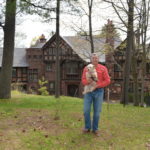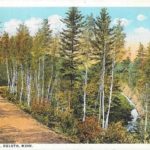Giant among giants slain along Congdon
October 10, 2013, I took a trip to Copper Harbor to visit the old-growth stand of white pines, many said to be saplings around the time Columbus visited America. Then while passing through Congdon Park a few days later, discovered the most amazing tree I’d ever seen appearing larger than the trees in Michigan. Looking at old photographs of the hillsides of Minnesota towns rising out of the prairies and hills of the 19th century, trees are absent throughout, scalped from the earth as far as the eye can see. Maybe some buffalo hides stacked over by the saloon, a church, a brothel, somebody feeding pigs behind the blacksmith’s shop, but no trees. This got me to wondering if Marjorie Congdon herself had protected this tree, wrapping her arms around it passionately in her lovely white dress while the press snapped photos.
There it was in the autumn light though, spiraling into the sky, a vast oasis unto itself. Through sheer fortitude, having carved its way into rock along the banks, supported precariously by one large main root, but with an all too extreme angle for its massive size. When I went down there yesterday evening, it lay a broken shattered remnant of its glorious former self. I’m guessing it fell during that last easterly storm. A dentist or lawyer nearby whilst listening to Brahms in near slumber after three glasses of wine might’ve heard it snapping smaller trees in half as it tumbled to the chasm below, shaking the earth and making the largest tree bridge ever known to man.
To gaze upon it in its former glory, to imagine where this tree had been… How many had walked by it hundreds of times never noticing, yet the lucky few who did, loathing it regardless for its imperfection. That it had the gall to grow not straight, but maleficent to the planet and God’s wishes to spite the odds while towering above twenty five generations of short lived earthlings for centuries. Maybe you know of this tree because you saw it once too? You surely breathed its air. So here’s to you Mr Southwest Leaning Ancient White Congdon Pine. May someone make a fine statue of the mayor out of you.
Recommended Links:
Leave a Comment
Only registered members can post a comment , Login / Register Here













20 Comments
emmadogs
about 10 years agoHerzog
about 10 years agoHerzog
about 10 years agoPaul Lundgren
about 10 years agoHerzog
about 10 years agoHerzog
about 10 years agoHerzog
about 10 years agoHerzog
about 10 years agoPaul Lundgren
about 10 years agoemmadogs
about 10 years agoHerzog
about 10 years agoHerzog
about 10 years agoPaul Lundgren
about 10 years agoHerzog
about 10 years agoTony D.
about 10 years agoheysme
about 10 years agowskyline
about 10 years agohbh1
about 10 years agoHerzog
about 10 years agoHerzog
about 10 years ago